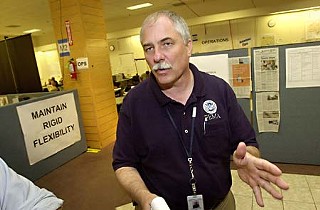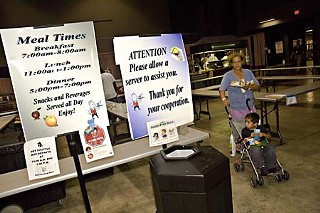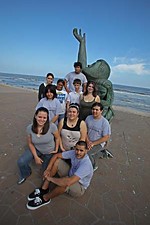Another Ill Wind
Ike's aftermath leaves aid agencies picking up the pieces
By Richard Whittaker, Fri., Sept. 26, 2008
The winds of Hurricane Ike may have bypassed Austin, but as evacuees move out of short-term shelters and state and federal agencies focus on coastal reconstruction, the city will play an evolving support role for weeks and months to come. As Austin Independent School District spokesman Andy Welch put it, "Every day we try to determine what the challenges are and address them, then move on to the next day."
While the Federal Emergency Management Agency, the governor's office, and the city's Office of Emergency Management each played a rescue and administrative role, the heavy lifting in helping evacuees – shelters, food, provisions, and clothing – fell to volunteers and charities like the American Red Cross. "A lot of people think that we're a taxpayer agency or we're part of the government," said Red Cross spokesman Marty McKellips. "We're partners with FEMA, but we can't speak for FEMA, and we get a lot of questions about them that we can't answer."
FEMA was already in town before Ike hit. Deputy federal coordinating officer Kenneth Clark explained, "We were here for Gustav, in the Embassy Suites, working out of their conference facility." When Ike struck, the small operation quietly took over the east end of Highland Mall and expanded. Sealed since J.C. Penney moved out two years ago, it is now FEMA's joint field office, coordinating the mammoth rescue, damage assessment, and reconstruction activities. A mixture of state and federal agencies, dress shirts, military and police uniforms, and the ubiquitous FEMA blue T-shirts fills the building. "FEMA has staff, and then we have the disaster reserve work force," said Clark. "They have a wide range of skill sets that we use, all the way from admin to operational support. On top of that, we have all the federal agencies."
Running 24 hours a day, with staff on 12-hour shifts, the Highland Mall site is a combination of rear staging area and communications hub, while major FEMA operations are run out of the Reliant Center in Houston. It is a warren of recently built office cubicles, separated by blue, padded partition boards. A rewired electrical system and computer network connects the hundreds of staff from dozens of agencies that make up the emergency support function groups. Each group has a particular task and coordinating agency, from ESF1 (transportation, under the U.S. Department of Transportation) to ESF15 (external affairs, run by the Department of Homeland Security). "We have our individual assistance programs, which will get people back into their homes," said Clark, "and then there's our public assistance, which is the government end, getting infrastructure back up." As personnel flood in from out of state, some get desks, others get instructions and head coastward. The staff, many of whom are Katrina veterans or Gulf residents themselves, is here for the long haul. As FEMA spokeswoman Patricia Brach explained: "As long as the state needs us, we'll support the state. That's the bottom line."
Who's in Charge?
This is solely an administrative center, situated in Austin because it's the state capital. The people crowded into Red Cross shelters around town are point-to-point evacuees, many shuttled on buses because of a standing emergency agreement between Austin and Galveston. When Ike was thought to be heading toward Corpus Christi, the expectation was that San Antonio would be the safe haven: As it turned northeast, the Galveston agreement activated. As evacuees arrived, AISD and the Red Cross opened shelters in schools along their routes; as one filled up, the next opened. This meant breaking out the Red Cross evacuation shelter manager kits. These aren't a complete shelter in a box but the signs, forms, phone lists, and manuals needed to create the space for people and supplies. "Up until about a year ago, we were named in national federal disaster plans as the agency responsible for mass care. ... That was changed because we felt, mutually, that you needed to have federal government authority behind calling up certain kinds of resources."
Responsibility is a complicated issue, Welch explained. "The Red Cross, to our way of thinking, is the lead agency, and we do everything we can to be accommodating, and then FEMA steps in to compensate us for our costs." That's the theory; once the doors open, he added, "it's always a matter of interpretation and the people involved." But McKellips stressed that AISD's involvement meant more than just letting them borrow space. "They're very generous to let us do this," she said, "because a lot of school districts won't do that because it's such a lot of work for them."
After the initial influx, evacuees were moved out of short-term shelters. Some returned home. Some rented accommodations or stayed with friends. Others moved to centralized shelters: the city-run Austin Convention Center, AISD's Delco Center and Toney Burger Activity Center, the mothballed Bowie Elementary in San Marcos Independent School District, and a small medical-needs facility at the J.J. Pickle Research Campus. Compared to bare school floors, the Convention Center's spartan facilities were an improvement. The roughly 1,200 residents were given two of the exhibition halls: one as a huge open dormitory with low cots, the other as a combination cafeteria/TV room/library/game room, with a trailer converted into a shower unit at one end. Head counts are held at 3am, because it's easiest to count sleeping bodies. Again, there were complicated government and nongovernmental organization liaisons – like Capital Metro ferrying evacuees to Goodwill to use their Red Cross-issued clothing vouchers. For many residents, it was a slow process of waiting for days for that all-important FEMA number, which would bring access to food stamps, Medicaid, state Temporary Assistance for Needy Families funds, and disaster unemployment benefits. The Red Cross also provided this service for evacuees staying outside the shelter, while FEMA opened a disaster recovery center, providing individual assistance, at the Givens Recreation Center. "It'll be a one-stop shop," said McKellips, "with FEMA and Red Cross representatives and all the other agencies all in one place so we can run everyone through there and get the maximum assistance they can."
By Friday, the Capital Area Food Bank – another charity – had received 300,000 pounds of food and $400,000 in private donations in one week and handed 5,500 food packages directly to evacuees not staying in the shelters: not because they were part of any response plan but because they could. Kerri Qunell, the food bank's vice president of communications, explained, "Because we have the staff and warehouses to accept donations and we have volunteers to package them, we have an efficient process to distribute them directly." After Saturday, they went back to distributing to their partner agencies. "We're just doing what we can to get food to the evacuees," she said.
Volunteers and Uncertainty
Without volunteers, the process would collapse: About 450 city employees helped in shelters, but others traveled farther. On Sept. 16, 66 city staffers set off for Houston under statewide mutual assistance agreements for what are expected to be two-week cleanup deployments. Volunteers from Solid Waste Services, Public Works, Parks & Recreation, Watershed Protection, and Fleet Services met with 25 Austin Energy linemen who had first traveled to Shreveport, La., to lend assistance there. The agencies they left behind may be working skeleton crews. Parks & Recreation, already understaffed, sent seven of its 25 forestry technicians. "It's a big part of our operation, and we're missing them already, but our neighbors needed some help," said parks operation manager Troy Houtman. "So, in the meantime, we're prioritizing work, and some things that are less important are coming down the list."
As the cleanup continued, the stark reality set in that many coastal communities won't be livable for weeks or possibly months. On top of this, the Convention Center clock was always ticking down to Sept. 26. While evacuees had shared the building with several prebooked conferences, previously scheduled major electrical repairs would make a shelter there impossible. This meant that, while the Burger shelter had already closed and some families moved out of the Delco Center, others moved in. "Our biggest concern," said McKellips, "is people who are staying with friends and family who just can't stay in that situation, and they start coming to us for shelter."
Then there's education. Rather than immediately enrolling evacuated kids in school, AISD initially provided museum and library trips, theatre activities, and physical exercise: "The kind of educationally grounded programs and services we can provide while those folks make their way to FEMA," said Welch. By Sept. 19, 55 evacuated students from all grades had already registered with AISD. Welch stressed that while the students are welcomed, "The whole directive from [the Texas Education Agency] was that, unsettled as these families are, it may serve them well to wait a week before making those decisions."
Now the challenge is finding homes. By Sept. 19, the Capital Area Food Bank was asking its partner agencies around Central Texas if they had any space in their facilities or knew of any affordable housing – a tough request in Austin's already overcrowded housing market and one that raised the very real possibility that displaced families might have to move elsewhere in the region. Some were waiting for FEMA to allow the Red Cross to move into the affected areas and do door-to-door assessment of damage to homes. For others, the damage is irrelevant. They just can't afford to return. "We saw some people came back to us who'd been here just two weeks before," said McKellips. "I know the financial strain the first time, but the second time, they're completely dependent on us."
Got something to say on the subject? Send a letter to the editor.












